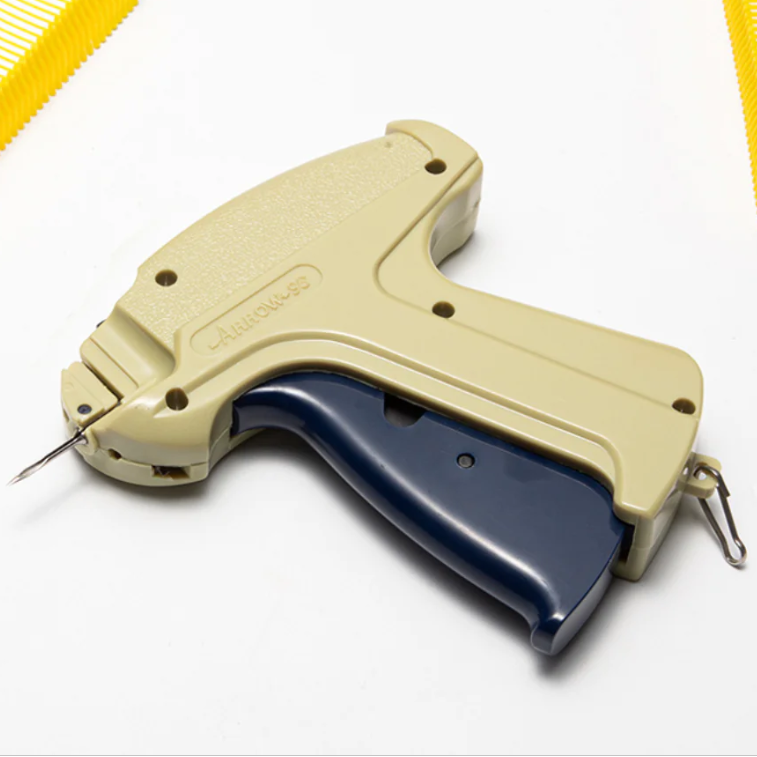How to Load a Tagging Gun?

1.Brief Overview Of What A Tagging Gun Is And Its Use
A tagging gun is a handheld device for attaching tags to various items, such as clothing, linens, and soft goods. The device uses fast-moving needles to penetrate the material and attach the label, making it a quick and efficient way to tag large volumes of items. The tagging gun can be used in retail stores, warehouses, and distribution centers, as well as in the garment and textile industries. Tagging guns are also helpful for organizing household items and personal belongings. They are commonly used with barcode scanning systems, allowing businesses to track inventory and manage stock levels more effectively.
2.Importance Of Loading A Tagging Gun Properly
Loading a tagging gun properly is important to ensure its smooth and efficient operation. If the gun is not loaded properly, the needle may become jammed, the tag may not be attached properly, or the gun may not work. To load a tagging gun, first, ensure the gun is in the unloaded position and the needle is in the up position. Then, insert the end of the tag into the gun's tag loading compartment, with the barcode facing forward. Next, pull the trigger to feed the tag into the gun, making sure the tag is fully loaded, and the gun is in the ready position. Finally, test the gun by attaching a tag to a piece of scrap material to ensure it is working correctly. Loading a tagging gun correctly will help save time, reduce frustration, and prevent mistakes.
3.Different Types Of Tagging Guns Available In The Market
Several types of tagging guns are available in the market, each designed to cater to specific needs and requirements.
One of the most common types of tagging guns is the standard tagging gun, also known as a single-line tagging gun. This type of gun is simple and suitable for tagging small items such as clothing or accessories.
Another type of tagging gun is the multi-line tagging gun. As the name suggests, this type of gun can print multiple lines of information on the label, making it ideal for tagging larger items or items with more information to be displayed.
For businesses that require more durability, there are heavy-duty tagging guns. These guns are built to handle high-volume use and are made with sturdy materials to withstand frequent use. They are typically used in warehouse and industrial settings.
There are battery-operated tagging guns for those needing a portable and compact tagging solution. These guns are lightweight and can be used anywhere, making them perfect for businesses that frequently change locations.
Finally, for businesses that require a more customized labeling solution, there are thermal transfer tagging guns. These guns use heat-sensitive labels and can print high-quality, professional-looking labels in full color.
The type of tagging gun you choose will depend on your specific needs and requirements. Consider factors such as the size of the items you are tagging, the amount of information you need to display, and the durability you need before making a decision.
4.Materials Needed to Load a Tagging Gun
In order to use a tagging gun effectively, you will need to have certain materials and accessories on hand.
Here is a list of the most important materials required to load a tagging gun:
Tagging Gun - This is the most obvious item that you will need. You can purchase a tagging gun from a variety of retailers, including online stores and local craft supply stores.
 Many Mainstream Platforms Retail And Sell Tag gun
Many Mainstream Platforms Retail And Sell Tag gun
Tagging needles - Tagging needles come in a variety of sizes and styles, and you will need to choose the right one for your specific project. Some of the most common sizes are standard and fine.
Tagging fasteners - Tagging fasteners, also known as barbs, are small plastic or metal pieces that attach the tag or label to the material. You can find these in a variety of colors and styles, and you should choose the ones that best match your project needs.
Spare parts - It's always a good idea to have some spare parts on hand, such as extra needles and fasteners, in case you need to make a quick replacement.
5.Step-by-step Guide To Loading A Tagging Gun
A tagging gun is an essential tool for businesses that need to tag and price their products for sale. Loading a tagging gun can be a bit confusing for those who are unfamiliar with the process, but with these detailed instructions, you'll be able to do it with ease.
Step 1: Acquire the Right Needles and Tagging Fasteners.
Before you start loading your tagging gun, make sure you have the right needles and tagging fasteners. There are different types of tagging guns, and each one requires specific needles and fasteners, so make sure to check the manual for your specific model.
Step 2: Prepare the Tagging Fasteners Next.
Take the tagging fasteners and place them in a row on a flat surface. Make sure they are facing the same direction and that the hooks are facing up.
Step 3: Load the Tagging Fasteners into the gun.
With the hooks facing up, place the end of the tagging fasteners into the loading slot on the gun. Push the fasteners into the gun until they are securely in place.
Step 4: Attach the Needle With the fasteners loaded.
It's time to attach the needle. Screw the needle onto the end of the gun. Make sure it is securely attached before you start using the gun.
Step 5: Test the Gun Finally, test the gun to make sure it is working properly.
Place the tip of the needle against a piece of paper and squeeze the trigger. The needle should penetrate the paper and the fastener should be securely attached.
In conclusion, loading a tagging gun is not as difficult. With these detailed instructions, you'll be able to load your tagging gun with ease and start tagging and pricing your products in no time.
6.Common Mistakes To Avoid While Loading A Tagging Gun
Loading a tagging gun can be a simple process, but mistakes can happen, leading to improper functioning. Here are some common mistakes and how to avoid them for successful tagging.
First, not inserting the needle correctly into the gun. This can cause the tag not to release properly or the needle to become bent. Ensure the needle is securely in place before use.
Second, incorrect placement of the tag attachment on the needle. If the tag is not securely fastened to the needle, it will not release properly. Double check the placement before use.
Third, using the wrong size needle for the tag. Each tag and needle size is specific; using the wrong size can lead to improper release or damaging the tag or clothing.
Fourth, not using enough force when attaching the tag to the garment. Tagging guns require a certain amount of force to attach the tag; using too little force properly can result in the tag falling off.
To avoid these mistakes and ensure proper loading of the tag gun, carefully read the instructions provided with the gun and always double-check before use. Using the correct size needle and applying the correct amount of force will result in successful and secure tagging.


 Various Tag Guns
Various Tag Guns

 Heavy
Heavy 


